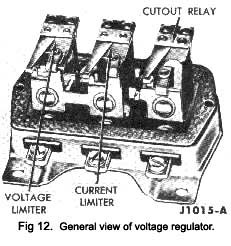DESCRIPTION (Refer to Fig. 12).
The generator voltage regulator is composed of three control units, mounted as an assembly. Each unit has a set of contact points and an energising coil for operating the points, and each of the units performs a separate function to maintain control of the generator.
Cut-out relay
When the engine is not operating, the contact points of the cut-out relay are held open by spring tension.
At approximately 12 volts, the coil is energised suffi-ciently to overcome the spring tension and close the cut-out points, thereby connecting the generator to the external load.
Voltage limiter relay
The voltage limiter relay holds the generator voltage be-low a predetermined setting by controlling the amount of voltage applied to the field coils. The voltage limiter thus protects the battery, lighting and ignition system etc., from high voltage when the system load-demand is low.
Current limiter relay
The current limiter relay protects the generator armature windings by limiting the maximum amount of current supplied by the generator. Like the voltage limiter relay, the current limiter relay performs its function by con-trolling the amount of current that is supplied to the generator field coils. The current limiter thus protects the generator when the system load-demand is high.
Temperature compensation
The generator regulator has been designed to exercise automatic control over the generating system, and also to compensate for seasonal temperature changes. In cold weather a higher voltage output is required to _ handle the load and in warmer weather, the voltage must be reduced to avoid overcharging the battery. The
|
temperature compensation is built into the regulator unit by making the armature hinge of bi-metal. The tempera-ture sensitivity of the bi-metal causes the regulator voltage setting to change according to temperature. It is necessary, therefore, to establish a “normal” or stabilised regulator operating temperature to coincide with the specified voltage setting of between 14.6 and 15.4 volts. The standard ambient temperature established for this setting is between 70°F and 80°F (21.1°C and 26.7°C). The regulator temperature for this or any other setting is defined as the temperature of the regulator after half-an-hour of operation in the car or, after the regulator has been heated until it becomes stabilised.
Note:—For correct voltage adjustment, first ensure that the regulator has reached “ normal” operating tem-perature as defined in the previous paragraph ; then make the voltage adjustment setting to coincide with the prevailing, ambient air temperature. The correct voltage limits for various ambient air temperatures is given under the heading of General Data. |
 **
**
